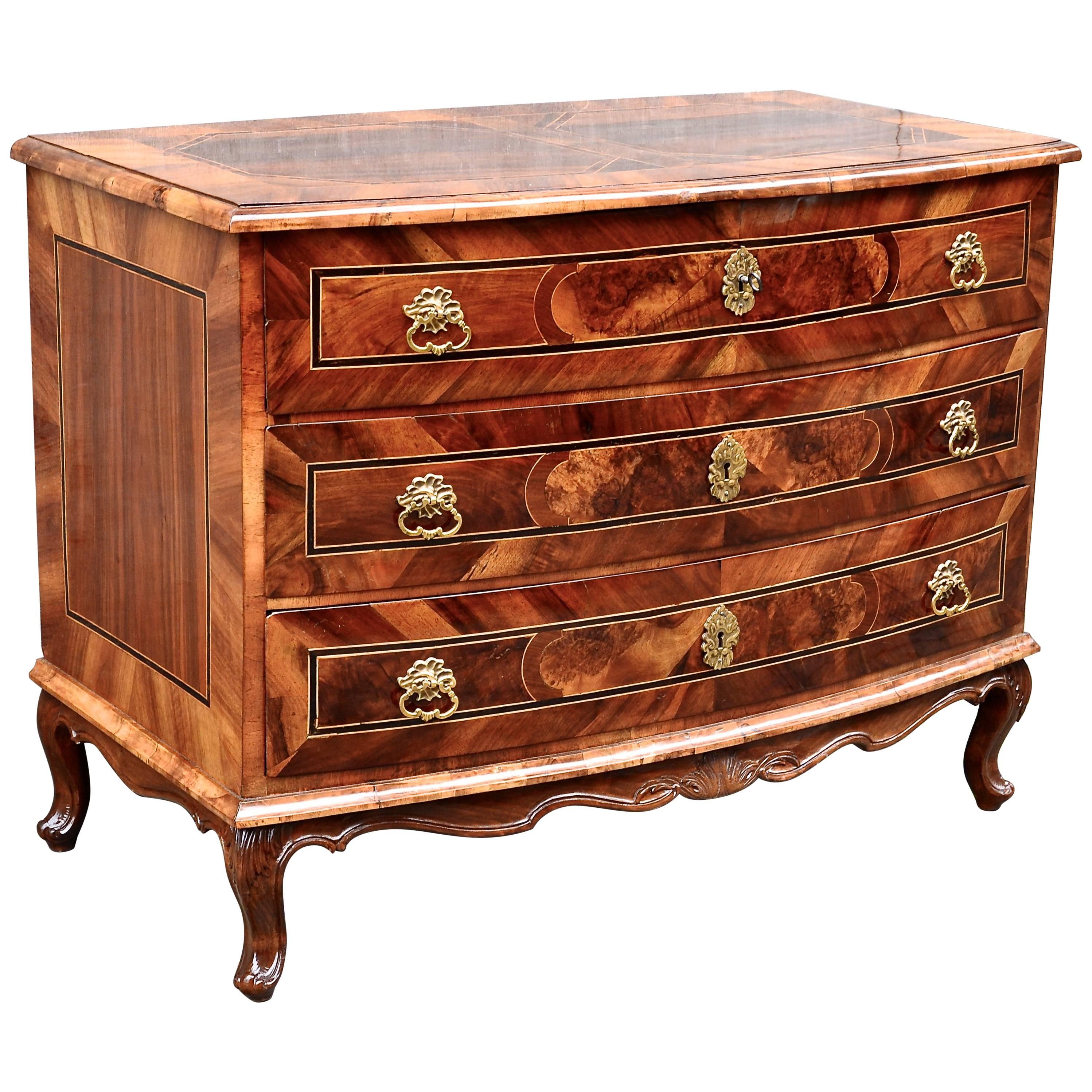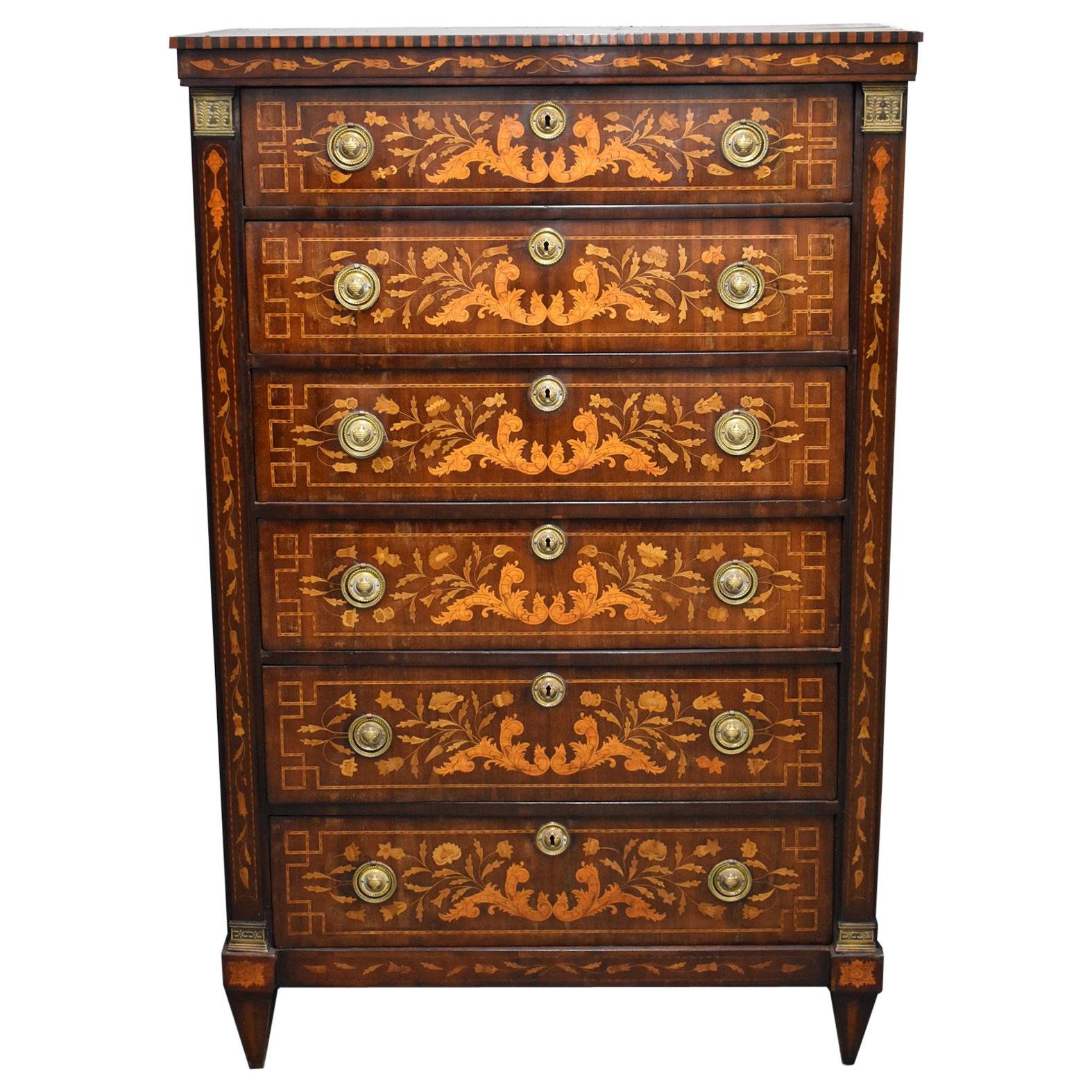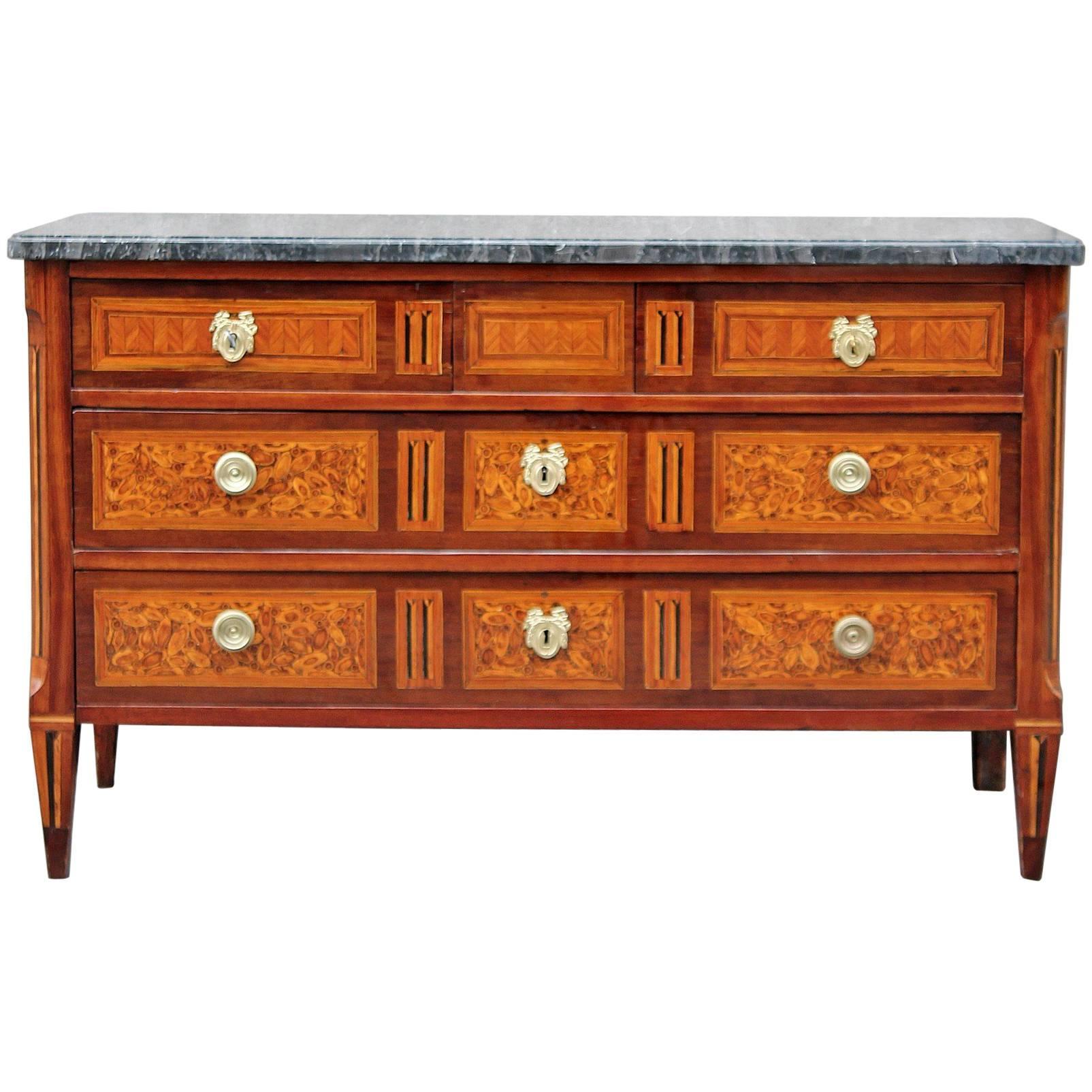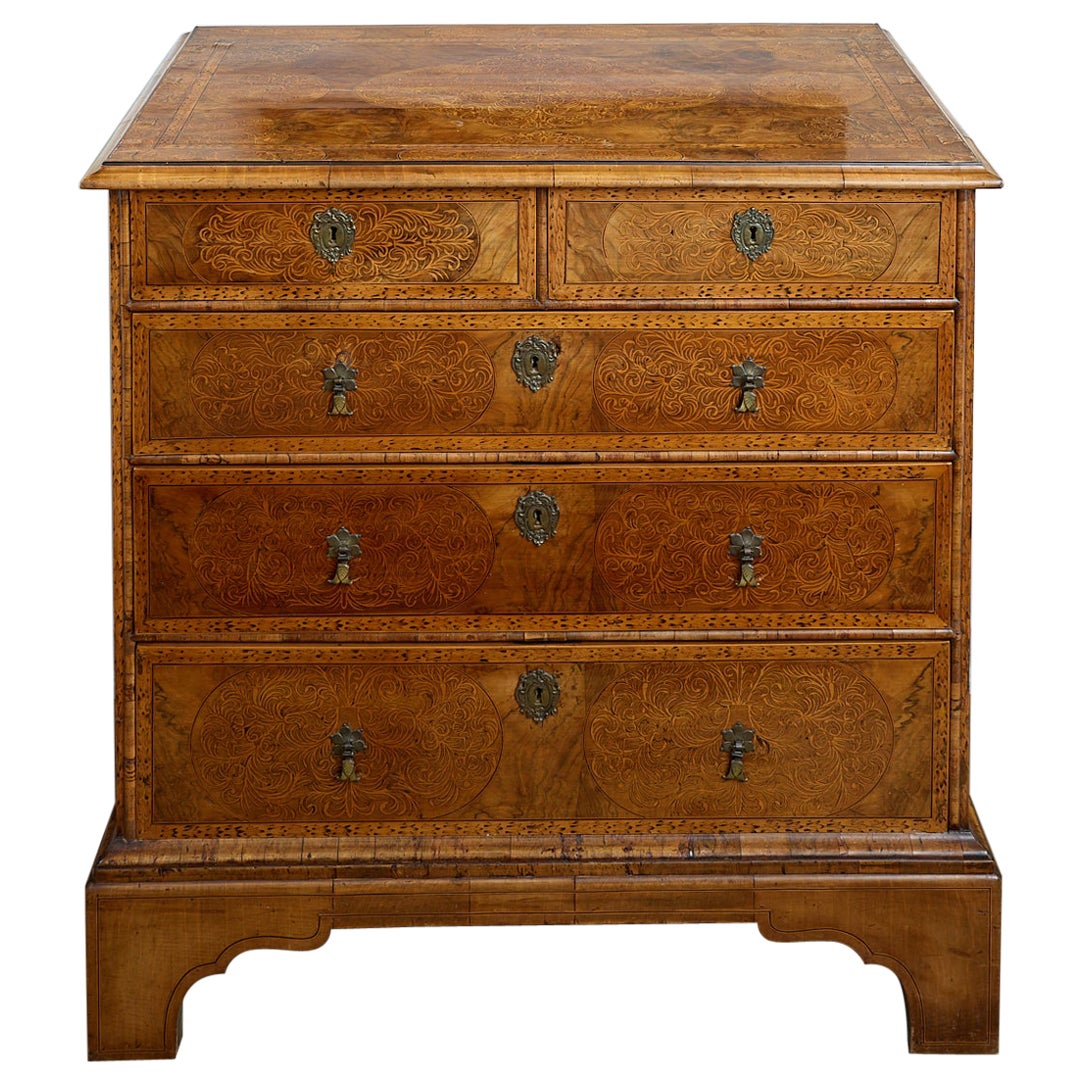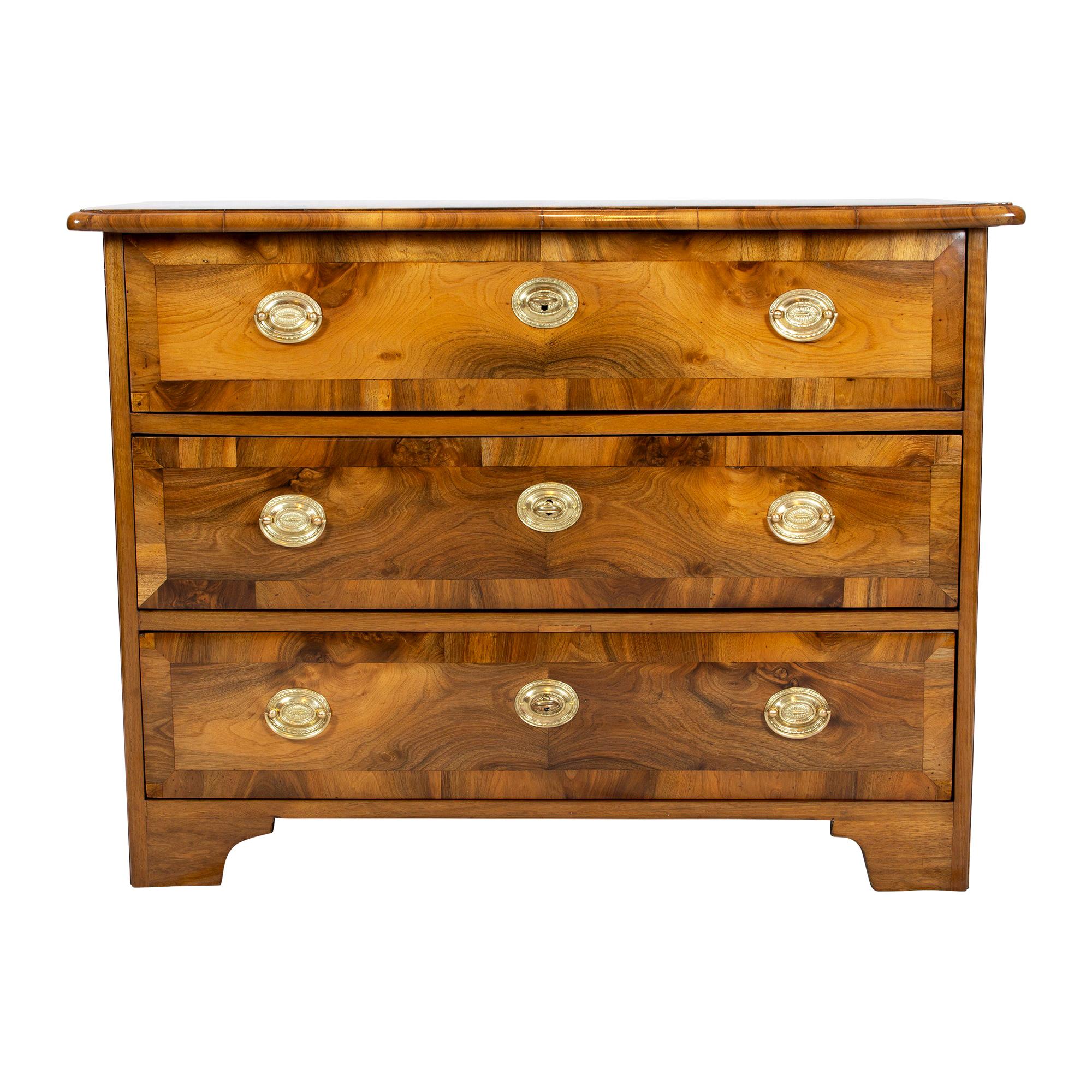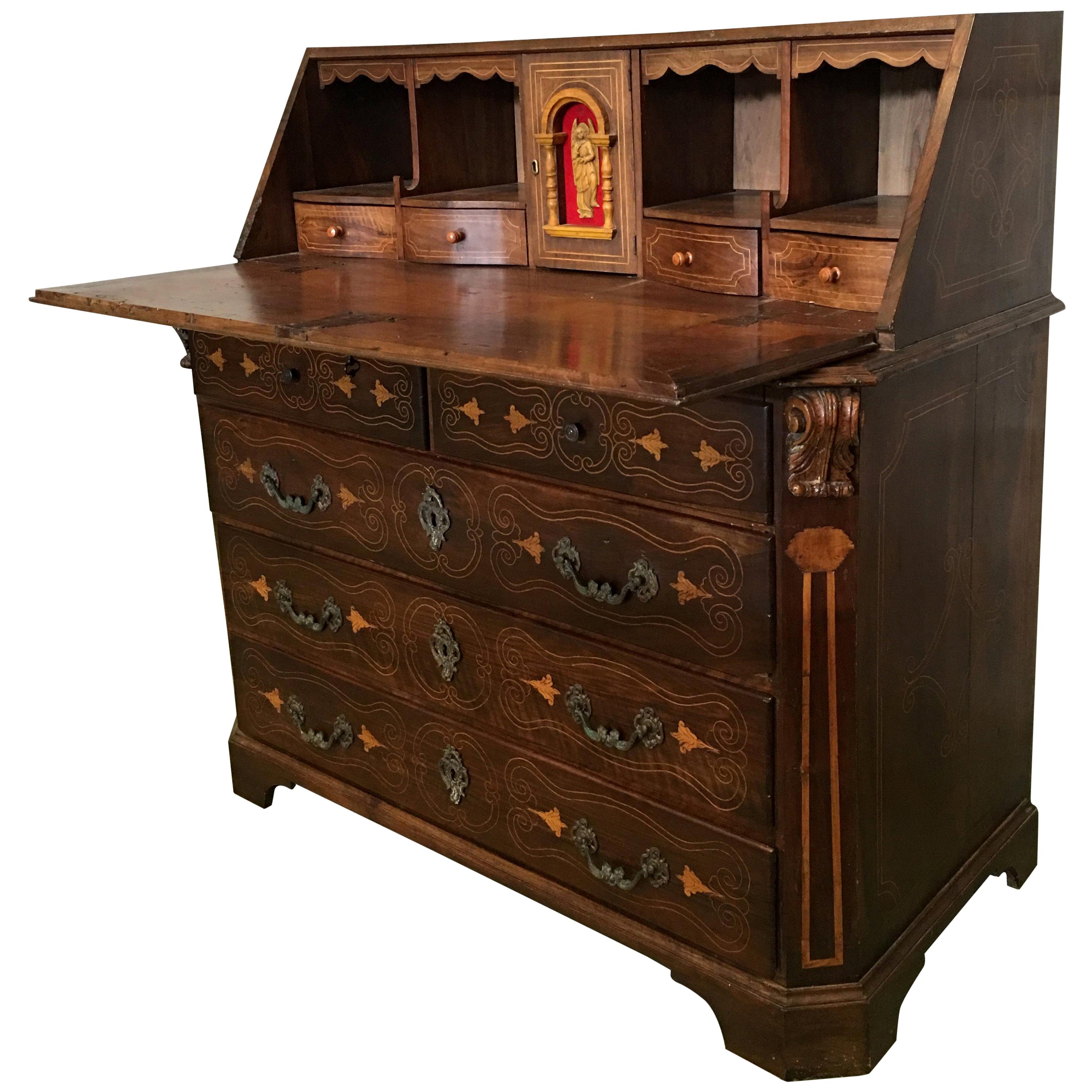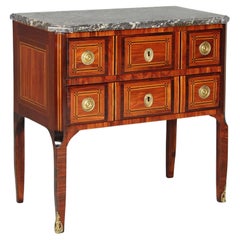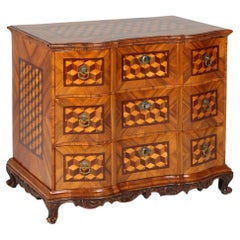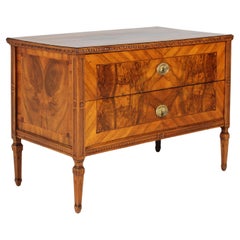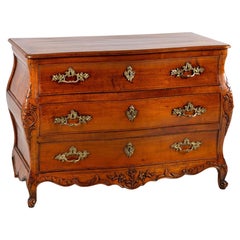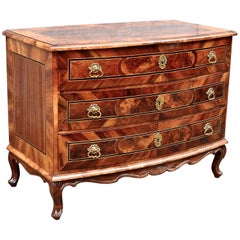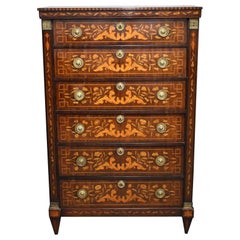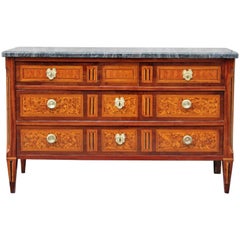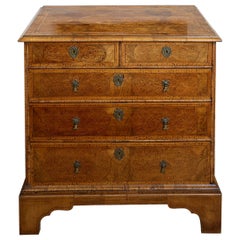Artículos similares a 18th Century Chest Of Drawers with Marquetry, by Johann Adam Sauer, circa 1785
Cargando vídeo
¿Quieres más imágenes o vídeos?
Solicita imágenes o vídeos adicionales al vendedor
1 de 21
18th Century Chest Of Drawers with Marquetry, by Johann Adam Sauer, circa 1785
Acerca del artículo
Antique chest of drawers with marquetry
Fulda
Walnut, maple and others
circa 1785
Dimensions: H x W x D: 85 x 120 x 57 cm
Description:
Antique chest of drawers in the typical style of Johann Adam Sauer with a still baroque form but already classicist surface design.
The ebonised plinth stands on profiled ball feet and corresponds with the edge of the top.
The front of the piece of furniture has multiple bends and curves, the plinth and top follow this shape. The three drawers are each divided into three sections surrounded by diagonally veneered walnut. Framed by light and dark contrasting rosewood and maple inlays, the outer panels are veneered in birch burl and fitted with gilded brass fittings. The centre panels are framed in the same way and marked with floral images in maple. The four dominant vertical divisions of the furniture front feature light-coloured foliage on a dark background, a design element typical of the Sauer workshop.
The large, original iron lock mounted in the middle drawer, which locks upwards and downwards and thus closes all three drawers, is impressive. The two other drawers therefore do not require a lock, although there is also a box lock in the top drawer, which was probably added during an older restoration.
The sides of the chest of drawers correspond to the design of the front, they are similarly structured and inlaid using the same types of wood. The classical style is even more clearly visible here with the geometric structure on a straight surface than on the front of the furniture.
The top panel is spectacular, the front edge of which shows the multiple bends of the furniture front.
The marquetry shows a well-filled flower basket with garden tools, framed like a cartouche with the leaf friezes already familiar from the front. The flowers and stems give a hint of the old colour scheme. Not only these inlays, but also those on the front and sides were certainly much more colourful originally than we see today. The blue, red and purple tones have completely faded over the centuries, with only the delicate green colours still partially preserved here.
Interesting facts:
Johann Adam Sauer was born in Fulda on 14 August 1745 and died there on 30 January 1822.
Influenced by his family, which had been rooted in the carpentry trade for generations, he passed his master craftsman's examination in his mid-20s. Under the regency of Prince-Bishop Heinrich von Bibra (1759-1788), Fulda's economic situation flourished and there was a new demand for luxury furniture. Johann Adam Sauer set himself apart from his contemporaries with his innovative furniture designs and unusual marquetry and, together with the court carpenter Carl Philipp Arndt, is today regarded as one of the few carpenters in the region who was able to hold his own in the competition with the furniture manufacturer Roentgen in Neuwied.
Furniture by Johann Adam Sauer is in the possession of the Vonderau Museum in Fulda and the Bavarian National Museum in Munich.
It is thanks to the research work of Stefan Semler that good information on the life and work of Johann Adam Sauer is once again available today. In 1995, Semler organised an exhibition in Fulda to mark the 250th anniversary of Sauer's birth; a booklet written for the occasion is included with the chest of drawers on offer here.
Condition:
Refurbished and suitable for everyday use with a shellac hand polish.
Please compare the following literature:
Wolfgang L. Eller - Möbel des Klassizismus Louis XVI und Empire p.45 and p.118
Stefan Semler - Johann Adam Sauer - Schreinermeister und Ebenist in Fulda
- Dimensiones:Altura: 85 cm (33,47 in)Anchura: 120 cm (47,25 in)Profundidad: 57 cm (22,45 in)
- Estilo:Luis XVI (Del período)
- Materiales y técnicas:
- Lugar de origen:
- Época:1780-1789
- Fecha de fabricación:1785
- Estado:Refinado. Desgaste acorde con la edad y el uso. Refurbished and suitable for everyday use with a shellac hand polish.
- Ubicación del vendedor:Greven, DE
- Número de referencia:1stDibs: LU5419245308372
Sobre el vendedor
4,9
Vendedor Oro
Vendedores premium que mantienen una calificación de +4,3 y tiempos de respuesta de 24 horas
Establecido en 2014
Vendedor de 1stDibs desde 2020
180 ventas en 1stDibs
Tiempo de respuesta usual: <1 hora
- EnvíoRecuperando presupuesto…Envío desde: Münster, Alemania
- Política de devolución
Partes de esta página se han traducido automáticamente. 1stDibs no puede garantizar la exactitud de las traducciones. El inglés es el idioma predeterminado de este sitio web.
Garantía de autenticidad
En el improbable caso de que haya algún problema con la autenticidad de un artículo, ponte en contacto con nosotros en un plazo de 1 año para recibir un reembolso total. DetallesGarantía de devolución de dinero
Si tu artículo no es como se describe, sufre daños durante el transporte o no llega, ponte en contacto con nosotros en un plazo de 7 días para recibir un reembolso total. DetallesCancelación dentro de las 24 horas
Tienes un período de gracia de 24 horas para reconsiderar tu compra, sin preguntas.Vendedores profesionales aprobados
Nuestros vendedores de primera clase deben cumplir estrictos estándares de servicio para mantener la integridad de nuestros anuncios.Garantía de igualación de precios
Si encuentras que un vendedor publicó el mismo artículo por un precio menor en otro lado, igualaremos ese precio.Entrega global de confianza
Nuestra red de transporte de primera ofrece opciones de envío especializado en todo el mundo, que incluye envío personalizado.Más de este vendedor
Ver todoCómoda de transición del siglo XVIII con tapa de mármol, Francia, hacia 1780
Cómoda pequeña con tapa de mármol
Francia
Palo de rosa y otros
Transición hacia 1780
Dimensiones: Alto x Ancho x Fondo: 77 x 78 x 43 cm
Descripción:
Delicada cómoda francesa del p...
Categoría
Antiguo, Década de 1770, Francés, Luis XVI, Cómodas y cajoneras
Materiales
Mármol
Cómoda barroca alemana de mediados del siglo XVIII con marquetería trompe-l'œil
Cómoda barroca con marquetería de cubos trompe-l'œil
Mainfranken
Nussbaum y otros
Mediados del siglo XVIII
Dimensiones: Alto x Ancho x Fondo: 82 x 92 x 61 cm
Descripción:
Cómoda b...
Categoría
Antiguo, mediados del siglo XVIII, Alemán, Barroco, Cómodas y cajoneras
Materiales
Nogal
Cómoda alemana Luis XVI con tallas y marquetería, hacia 1780
Cómoda clasicista antigua
Alemania
Nogal
hacia 1780
Dimensiones: Alto x Ancho x Fondo: 81 x 111 x 61 cm
Descripción:
Cómoda de dos niveles con fina decoración tallada, creada en e...
Categoría
Antiguo, finales del siglo XVIII, Alemán, Luis XVI, Cómodas y cajoneras
Materiales
Nogal
Cómoda provenzal francesa de mediados del siglo XVIII con hermosa pátina
Antigua cómoda provenzal
Francia
madera maciza de cerezo
Mediados del siglo XVIII
Dimensiones: Alto x Ancho x Fondo: 87 x 120 x 65 cm
Descripción:
Cómoda del sur de Francia, bella...
Categoría
Antiguo, mediados del siglo XVIII, Francés, Luis XV, Cómodas y cajoneras
Materiales
Cereza
Cómoda de la Regencia Francesa con Herrajes de Ormolina, Principios del Siglo XVIII
Cómoda Antique French Regence
Francia
Kingwood
principios del siglo xviii
Dimensiones: Alto x Ancho x Fondo: 84 x 130 x 65 cm
Descripción:
Cómoda representativa Regence de madera ...
Categoría
Antiguo, Década de 1720, Francés, Cómodas y cajoneras
Materiales
Mármol
Cómoda alemana de finales del siglo XVIII, nogal, restaurada con pátina
Cómoda clasicista
Sur de Alemania
Nogal y otros
finales del siglo XVIII
Dimensiones: Alto x Ancho x Fondo: 88 x 121 x 58 cm
Descripción:
Mueble de tres niveles que se alza sobre p...
Categoría
Antiguo, finales del siglo XVIII, Alemán, Neoclásico, Cómodas y cajoneras
Materiales
Nogal
También te puede gustar
Cómoda alemana de marquetería del siglo XVIII
Cómoda alemana de marquetería del siglo XVIII.
Categoría
Antiguo, siglo XVIII, Alemán, Luis XV, Cómodas y cajoneras
Materiales
Bronce
Cómoda holandesa de marquetería del siglo XVIII
Se vende una buena cómoda holandesa de marquetería del siglo XVIII. La cómoda tiene seis cajones profusamente incrustados y cada uno con tiradores de anilla de latón. Los lados de la...
Categoría
Antiguo, finales del siglo XVIII, Holandés, Colonial holandés, Cómodas y...
Materiales
Nogal
Cómoda francesa de marquetería del siglo XVIII, estampada J. Chastel
Por J. Chastel
Cómoda francesa de marquetería del siglo XVIII, estampada J. Chastel
Se ha sustituido el mármol.
Categoría
Antiguo, finales del siglo XVIII, Francés, Luis XVI, Cómodas y cajoneras
Materiales
Mármol
Cómoda inglesa del siglo XVIII con exquisita marquetería
Espectacular cómoda inglesa de cinco cajones del siglo XVIII, de nogal con incrustaciones de marquetería de madera de frutal. Cada cajón tiene un escudo de latón y tiradores de gota,...
Categoría
Antiguo, siglo XVIII, Británico, Georgiano, Cómodas y cajoneras
Materiales
Madera frutal, Nogal
4500 US$ Precio de venta
Descuento del 33 %
Cómoda de nogal con marquetería Luis XVI / Barroco del siglo XVIII
Cómoda de marquetería Luis XVI del siglo XVIII, con tres cajones, procedente de Alemania Occidental. Chapa gruesa de nogal aserrada con marco de nogal sobre un corpus de madera de ab...
Categoría
Antiguo, finales del siglo XVIII, Alemán, Luis XVI, Cómodas y cajoneras
Materiales
Latón
7791 US$ Precio de venta
Descuento del 23 %
Cómoda con solapa de marquetería de nogal español del siglo XVIII
Buró español de marquetería de nogal del siglo XVIII.
Se trata de un exquisito buró español antiguo, datado hacia 1780, este elegante buró pronto se convertirá en la pieza central...
Categoría
Antiguo, finales del siglo XVIII, Colonial español, Cómodas y cajoneras
Materiales
Arce, Nogal
8100 US$ Precio de venta
Descuento del 25 %
